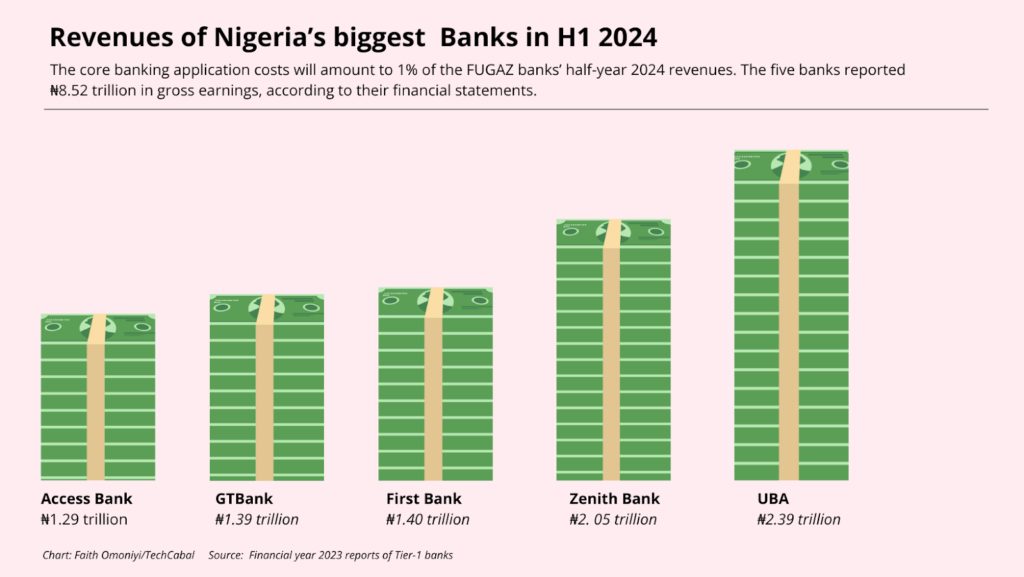Since September 2024, at least four Nigerian commercial banks have changed their core banking applications. Costs and a need for customisation drove these technological changes.
The frustrations of the process—millions of customers unable to access banking services—have been documented, but little has been said about the financial costs of these changes.
On October 14, Guaranty Trust Bank told customers it finalised its core banking platform switch to Finacle, weeks after TechCabal first reported the technology change. That switch could cost the bank up to ₦25 billion ($15.3 million) in yearly licence fees, said one person familiar with the matter.
Depending on the specifications of the core banking application, Nigerian commercial banks spend at least $10 million each year, the same person said. This suggests that the biggest Nigerian commercial banks—First Bank, UBA, GTBank, Access Bank, and Zenith—will spend $50 million (₦82 billion) annually on their core banking applications.
These core banking software costs will amount to 1% of the FUGAZ banks’ half-year 2024 revenues. According to their financial statements, the five banks reported ₦8.52 trillion in gross earnings.

With millions of customers to serve across hundreds of banking channels, the need to invest in technology is a no-brainer. Based on their capital raise presentations, three of Nigeria’s biggest banks will spend up to ₦224.22 billion ($136 million) on technology upgrades.
GTCO, the holding company of Nigeria’s cost-efficiency leader in commercial banking, planned to spend ₦98.5 billion on technology infrastructure upgrades. Access Holdings, the parent company of Nigeria’s biggest banks by assets, will spend ₦68.62 billion to upgrade and develop technology its infrastructure. Zenith Bank Plc, Nigeria’s largest lender by market capitalisation, will spend ₦57 billion on technology infrastructure.
These technology costs cover the core banking applications, customer relationship management (CRM) software, cloud storage, digital banking channels, risk management systems, ATM networks, database management systems, fraud detection systems, electronic document management systems (EDMS), among others.
While tier-1 banks can take these costs on the chin, tier-2 banks are keen to manage costs and find avenues for profits.
In September 2024, Sterling Bank, a tier-2 Nigerian bank with a market capitalization of ₦115.16 billion, switched to SEABaaS, a new custom-built core banking application. It hopes to recoup some of the building costs by selling SEABaaS to other banks in the near future.
The lender previously used T24 built by Geneva-headquartered Temenos AG. Cost considerations drove that switch, two people with direct knowledge of the matter said. Commercial banks often rely on different modules of the core banking software built to their specifications but that service is expensive. These modules include account opening, transaction processing, loan management, and risk assessment.
Changing a core banking application also requires several months of planning and internal approvals from a bank’s top management.
One person with direct knowledge of the matter said Sterling Bank first discussed the possibility of changing from T24 in 2022 and it took at least seven months before a new core banking application was built. GTBank’s switch to Finacle also began in the fourth quarter of 2023.
The process involves setting up a change management plan including a rollback strategy, a series of tests of the new core banking application in different environments, and navigating the bureaucracy of the bank’s leadership, one person familiar with the matter said.
“You’d need to get approval from all the different heads of the units in the bank before going live [with the new core banking application]. Sometimes, it turns into a vote,” that person said.
It also meant longer working hours for the technology team. Data migration is the most critical part of a core banking application. As one bank engineer described it, “billions of data including customer and transaction details are migrated to the new platform and you can’t afford to mess it up.”
The bank cleans and reformats existing data to ensure compatibility with the new system. Banks operate large and complex datasets with several millions of customers and transactions, that process could take weeks and often result in extended downtimes that leave millions of customers unable to access banking services.
Since the banks cannot share extensive details of their core banking changes, they risk losing customer trust. For now, banks will need to do more than issuing statements to pacify aggrieved customers











